
|
 |
Kitaplar » AQUACULTURE » Trout Farming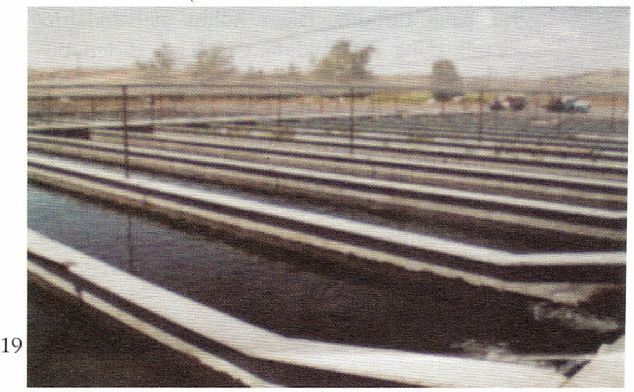
TROUT FARMING Prof. Dr Atilla ALPBAZ TROUT SPECIES WHICH ARE BREEDED BROWN TROUT (Salma trutto fario) 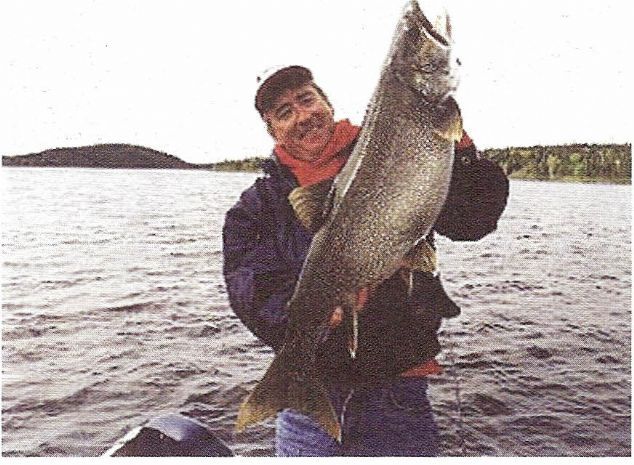 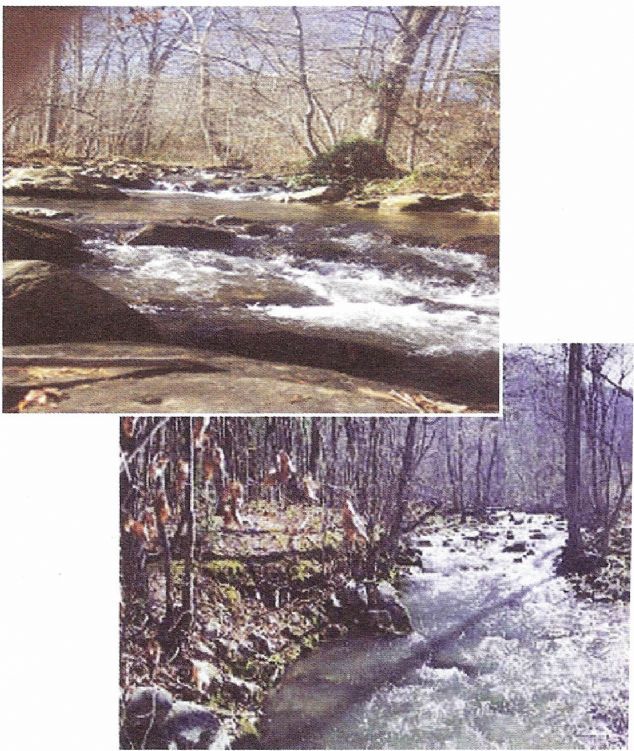 Picture : Many rivers in the US are privately owned or rented by the government to private individuals. For this reason, trout that are hardly caught by fishing line and raised in special hatcheries are used. Here, anglers make a payment according to the amount of fish they catch. Thus, fishing is supported in terms of sport and the population of fish is protected. Top Picture: Trout and salmon are important species in terms of consumption. In addition, it has a very important place in terms of sport fishing. It is valuable for fishermen due to its rich nutritional value and an enjoyable fishing experience. Whoever catches a large fish with a fishing rod will not forget this prey for life. Besides rainbow trout, other cultured trout species spread to the world from California. (Shasta Rainbow Trout) Its colors are clear. It has a small amount of dark black spots on it. It has broad red stripes on its side. Its growth properties are very good.
Salmo gairdneri gairdneri (Steelhead rainbow trout) originated in the United States. The red stripes on the sides are brighter. There are many red spots along the ridge line and near the back. They give eggs late.
WATER REQUESTS OF TROUTS
Streams, lakes and groundwater can be used for trout farming. Spring waters are the most suitable. It is desired that the water be clear. Potable, clean water is preferred. It is best to have the water temperature around 14-15 degrees in all seasons of the year. The water temperature for breeding can be between 7-15 degrees. The water temperature of fish raised for consumption should be slightly higher. A water temperature of 20 degrees does not pose a danger for rainbow trout. In fact, rainbow trout can survive at water temperatures of 23-24 degrees with good flow of water. However, it is still important to be careful about the temperature increase. Each species has different water temperature needs in different periods. For example, rainbow trout needs a water temperature of 10-12 degrees for spawning and incubation, 12-14 degrees during the juvenile period and 15-17 degrees for fattening are the most suitable temperature values for high productivity. In our country, trout cultivation in the salt water of the Black Sea has become widespread in recent years. Trout can easily live in sea water at a temperature of 20 degree if the water temperature is suitable. For this reason, trout can be grown in fishing net cages in the Black Sea when the water temperature is less than 17-18 degrees in winter. One of the first attempts on this subject in our country was made by the author of this book in 1978-1979 and it has been proven that it can be successful. It can be said that there is a great potential in our country in terms of raising fish in fishing net cages located in lakes and dams. In this regard, it will be in the interest of our country to create new opportunities by examining the water conditions of all our dams and lakes according to the seasons. (Not; in 2020 aproxamately 36000 tons of trout bred in Black sea in winter periot. And sold with the name of Turkish salmon )
The pH of the water should be between 6.5-7.5. It is preferred that the water be a little hard and the SBV value does not exceed 4. General information about SBV value and pH is given in fish breeding books. I recommend it to be examined. Trout are raised in water with plenty of oxygen. The reason why the water temperature should not exceed 20 degrees is because the oxygen amount is low in warm water. In other words, it is not the temperature of the water that disturbs the fish, but the low amount of oxygen in warm waters. For example, while there is 14 mg / lt of oxygen in water with a temperature of 10 degrees, there are 11.3-9.19 and 7,67 mg / lt dissolved oxygen in water at 10, 20 and 30 degrees. For trout, it is not good for the oxygen amount to fall below 6-7 mg / lt. Since trouts do not like water with low oxygen content, if a successful production is desired, water with plenty of oxygen and colder than 20 degrees is suitable. OTHER SUBSTANCES
Substances in trout waters should be potassium hydroxide (KOH) 15 ppm, copper 1 ppm, magnesium chloride (MgCl) 4000 ppm, lead nitrate (Pn (NO 2) 2 ppm, and lead chloride (PbCl) 0,3. There should be no lifter residue and organic residues in the water. Especially the water that goes to the pans with the eggs should be very clean. Because shaft and sand residues that can accumulate on the eggs can greatly affect the output power and cause the death of the eggs. Trout likes abundant, clear and cold waters. The photographs below show a trout farm by the river on the left and a trout breeding unit in cages established under a dam in South East Anatolia on the right. THE AMOUNT OF WATER Having a water flow rate of at least 100 lt / sec is ideal for setting up an average trout farming business. Trout can also be produced in resources with less water, but the resulting warming can be dangerous for fish. According to foreign publications, it is said that 6-9 tons of fish can be grown in a spring with 100 lt / sec water. However, if a good planning is made, it is possible to produce 15-20 tons of trout in 100 lt / sec water environment. In other ages, they suggest that 0.5-1 lt / minute water should be calculated for 1,000 eggs, 1-3 lt / minute for 0-2 month 1,000 juveniles, and 1 lt / minute for 1,000 fish of 4-8 months. For example, if the juvenile fish are 7 months old, it can be calculated that 7 lt / minute water is required for 1,000 fish. By the way, it should be remembered that; In the calculation of the water need of the fish, it is necessary to take into account the age of the fish as well as their development status. It is said that the water requirement should be kept slightly higher in groups that are well fed and develop fast. Water management is very important in fish farming. For example, 15,000 kg of fish can be grown in a spring containing 100 lt / sec water, and it is possible to increase this production to around 25-30 tons per year with a good management.
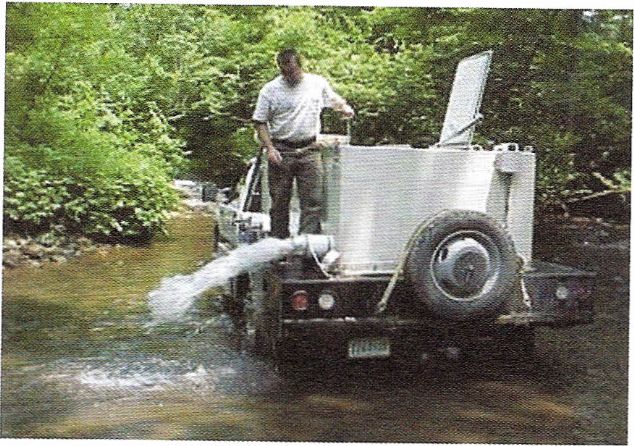 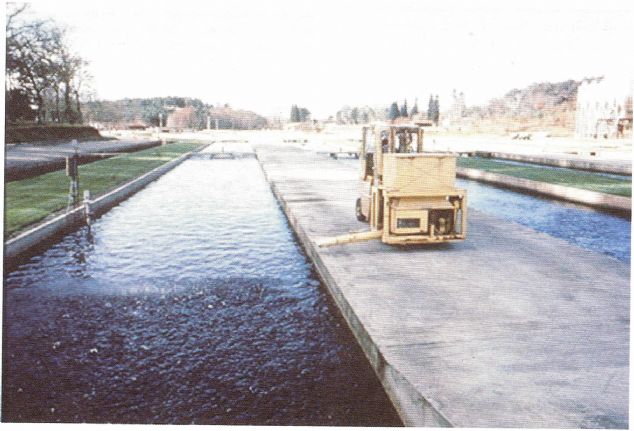 Top: In trout farming, important studies are carried out in terms of stockpiling natural rivers. Here, it is seen that fishing activities are carried out by leaving trout juveniles to the river in a foreign country. Buttom:: Trout farming ponds and automatic feding TROUT FACILITIES Whether the land is private property or deed reduces the establishment process. But treasury lands can also be rented. Some work must have been done before these leases. In our country, the rental process is mostly applied for 10-15 years and this period can be extended again. It will be beneficial if the cultivation area is close to the water source. Because the further away from the source, the greater the risk of heating, clouding and contamination of the water with foreign waste along the way. If the source is far away, the water can be brought unheated by the boom. The land should be suitable and suitable for pool construction. The water should be able to be taken into the pools with normal gravity and the pools should be easily emptied when desired. The operating area should be close to the source as mentioned before and the pool should be suitable for sandblasting. In addition to these, some different features are also sought. The most important of these is road condition. In order to transport the necessary materials during construction and to easily transport the product during production, there should be no transportation problems. It is also desired to be close to the market. Easy procurement of construction materials will reduce the cost of the facility. It is important that it is easy to provide labor and feed supply. Issues such as drinking water and electricity should also be considered. It can be said that there should be four types of pools in trout farms, namely breeding and stock pools, breeding pools, hatchery pools and juvenile production pools. Incubation pools and juvenile production pools are planned within the building. Because, eggs and offspring must be kept in a low light environment until they reach 3-5 cm. It should be known that eggs and very small offspring will die when exposed to direct sunlight.
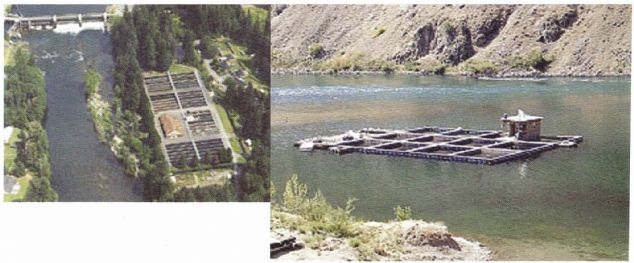 Picture: Left trout farm on the river bank, right at a dam exit, trout farming in fishing net cages. HATCHERIES AND HATCHER POOLS It is planned according to the amount of fish to be produced. They are built in a way that they can be covered, their windows can be closed and they can be dark. Inside the hatchery, there are hatchery channels where hatchery pans can be positioned. Incubators can be of various sizes. But it is usually designed for 50x50 cm pan sizes. For example, if 49x50x15cm sized pans will be used, 50cm. Transverse channels can be planned. For example, let's plan 20 tons of fish production in the enterprise. It means that 80,000 fish will be produced with the calculation of 250 grams of fish each. Considering that there may be a loss of 20% until the fish reach this age, it is calculated that around 100,000 eggs should be incubated. An average of 10,000 eggs can be placed in a pan. In this case, 10 incubation pans and the channel where they will be placed are required. 80,000 juvenile fish are kept inside the building until they reach 3-4 cm in length. It can be planned to build an inner pool of 30-40 m2 with the calculation that 2,000-3,000 cubs will be placed per 1 m2. These inner pools can be made 0.5 or 1 meter wide, 0.75 deep and 5-10 meters long depending on the building width. Pools with a width of 1 meter can also be used to use two incubators side by side when necessary. The water depth is adjusted so that when the eggs are placed, 5-8 cm of water is left on the top of the eggs. The first 1-2 months water depth is adjusted as 30-40 cm for larvae. As the fry grow, the water depth can be increased to 60-75 cm.
PRODUCTION POOLS and OTHERS
It is preferred that trout pools are made of concrete. 15-20 kg of trout can be grown in a water area. With proper breeding and conscious planning, it is possible to market 30 kg of fish in 1 meter compared to the year. Although it is possible to plan the pools in various ways, long pools with 2-4 meters wide canal types have been built in recent years. In our opinion, the ideal is 3 meters. The water depth can be between 1.20 meters and 1.40 meters. Water inlet and outlet are controlled and grate. In planning, strainers and drainage arrangements are carefully planned. The administration building, feed warehouse, a small laboratory, cold air unit and places where the personnel will stay are included in the planning. It will be healthy if the buildings are built in a place that allows the control of the pools.
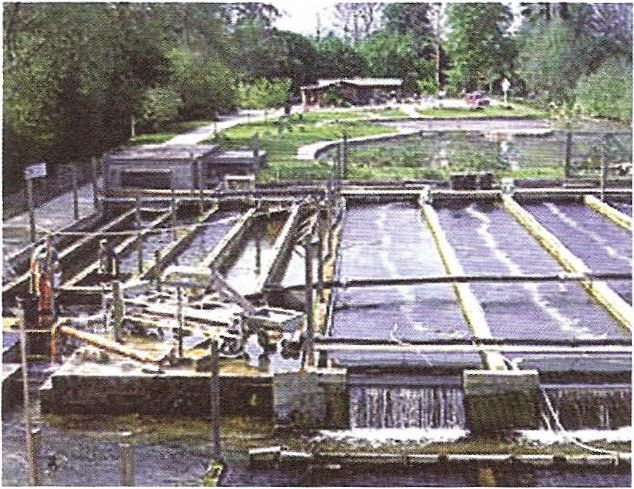 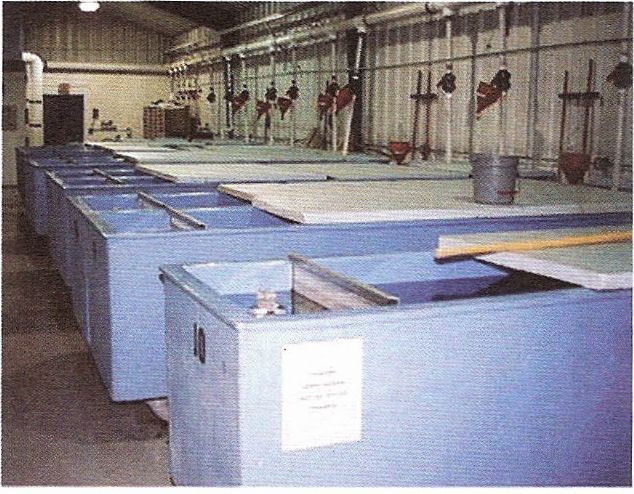 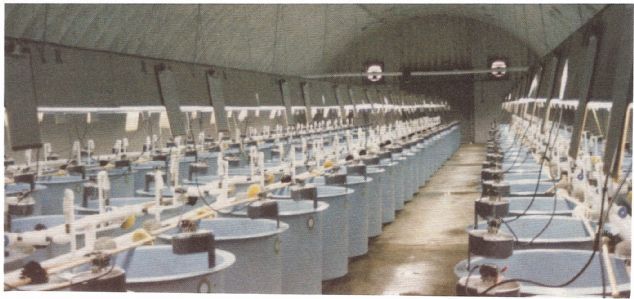 Pictures: Top: Trout fry and bargain fish production ponds Medium: Production pans for juveniles Lower. Trout production in indoor, round tanks
GENERAL INFORMATION ON TROUTS
In our country, trout are marketed as a portion, 3-4 of them are equivalent to 1 kg, that is, each fish weighs 200-300 grams on average. Rainbow trout can reach this weight in 10-12 months. In recent years, it has been observed that fish that are fattened in the Black Sea and around 1 kg are in the markets. A female trout weighing one kg can yield 1,600-2,000 eggs. Trout eggs are 4-5 mm in diameter. Rainbow trout farmed in our country take 21 days to hatch at a water temperature of 14-15 degrees. If the water is cold, this period will be slightly longer. For example, if the water is 12 degrees in 26 days, if it is 10 degrees in 30 days, the offspring will hatch. In some publications, hatching from eggs is specified in degrees / days. With this method, we can simply calculate how many days the baby will hatch in our business. For example, it is 300 degree/ days in rainbow trout and 400-450 degree/ day in brown trout. Let's say that the temperature of the water to be used in the incubators in our establishment where rainbow trout is grown is 14 degrees. This time, it is calculated that the offspring will hatch in 300/14 = 21-22 days. The group of reproductive cells taken from male trout by milking is called milk. 1 cubic centimeter of this milk contains millions of male reproductive cell spermatozoids. Milk can be taken from a male fish several times a season. For this reason, it is sufficient to keep 1/3 of the number of female fish in a business. Under normal fattening conditions, it is possible to get milk from a man every two weeks. At the time of spawning, the abdomen of the female trout is swollen, the anus is red, round and protruding. In male fish, the abdomen is flat. When the belly of the male fish is slightly pressed from the side, it is seen that white milk comes out. The male's color becomes bright and red at breeding time. In elderly mail, the tip of the mouth is curved upwards. It is sufficient to have 750 kg of breeding fish for a production of 1.000.000 eggs in an enterprise.
EGG and PUPPY PRODUCTION
Feeding is reduced 1-2 months before egg milking. As the spawning period approaches, the fish tend to gather where the water comes from. During this period, feeding must be interrupted or the amount of feed given is reduced. In addition, the fish are placed in specially prepared and cleaned pools by separating the males and females. For an efficient egg intake, it would be very beneficial to keep the feeding that started one year earlier in terms of quality and quantity at the highest level. Egg color is pinkish red in fish eating natural food, and the color of eggs obtained from fish raised with artificial food is pale white or slightly yellowish. However, offspring can be successfully produced from both color eggs. Feeding of breeding fish should be continuous. A good breeding feature cannot be expected from fish that are fed intermittently and are prevented from developing regularly. It is best for the female fish to be used in breeding to be 3-4 years old. However, eggs can also be successfully obtained from well-fed two-year-old fish. Male fish are desired to be between 2-4 years old. However, fish exceeding 350 grams in males or females can also be breeders. Fish over the age of 6-7 should be removed from the breeder. Because, infertility increases in these fish and the rate of fertility in eggs can be reduced by half. As the weight of the fish increases, the size of the eggs and the number of eggs to be obtained also increase.
BREEDING TIME
It can vary according to the trout species. It is generally between January and March in rainbow trout. But it can also differ according to individuals and lines. For example, in Japan, rainbow trout lines that give eggs in October-November have been developed by selection and selection. Selection, as it is known, is the process of selecting individuals who will create the new generation, and as a result, future generations emerge. The breeding time also differs according to the regions and climate. Strong flow of water is also effective. Reproduction time is earlier for fish in waters with strong currents. The health of the fish and a good feeding are also effective in early breeding. Studies have shown that fish age does not affect breeding time.
 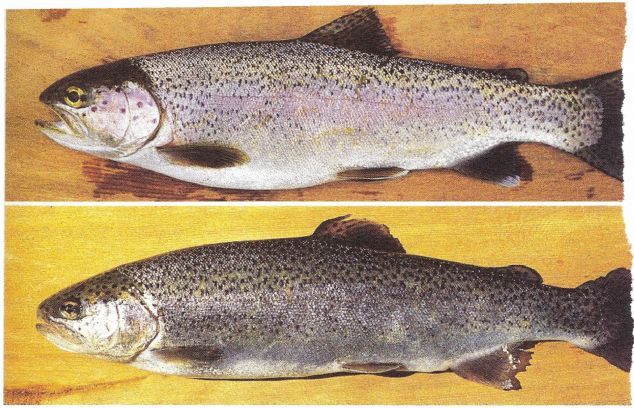 Picture: Top: Color increases in fish at breeding time Bottom: Male and female rainbow trout breeding in our country.
PRODUCTION
When the production time comes, the first thing to do is to separate the male and female fish. A fish catch car is required to catch all the fish in the ponds in a short time. The separated female and male fish are taken to small ponds. These pools should be close to the building where the fertilization process will take place. The depth of the pools should be 75-1 meters and their length should be around 2-3 meters. Thus, it will be easy to catch fish during the process. There should be no gravel or plants on the floor of these pools. Otherwise, fish will be prevented from laying eggs. It is best if the pools are made of concrete with a flat floor. The upper part of these ponds should be covered with a net or their edges should be 30-40 cm high in case the fish splash. Fish that have reached the time of spawning may show jumping behavior in order to go in the direction of the water. These pools where breeding fish are kept should be given as much water as possible. Thus, rapid development of sexual maturity can be achieved. But it is also not correct that the water current is too much. A current should be provided that does not drag the fish. The breeding fish in the ponds should be checked every week and it should be followed whether the egg retrieval time has come. Thus, the most suitable egg retrieval time can be easily determined and milking process can be started. If the female fish's abdomen is swollen and round, mature eggs emerge from the anus when a little pressure is applied, it means that the egg retrieval time has come or is very close. The milk of the males is creamy white at the time of reproduction. Bad milk looks watery. If the milk comes in a small amount when the male fish is pressed on the belly, or if it does not come at all, it is understood that it is not the breeding time. It is also possible to see bleeding. Mature eggs in female fish are round. The egg can remain mature for 8-10 days. Often male fish hatch from overripe eggs. Bad features can be seen in some of them. The fertilization rate may decrease. The mortality rate may be high both at the time of insemination, during the incubation phase after fertilization, and after the hatchlings hatch. For this reason, the milking process should be continuously controlled and done on time. It should not be forgotten that healthy fish will grow from the healthy fry to be obtained. Also, if the eggs are milked before they mature, it is possible to encounter the same problems. If no eggs are extracted from the female fish for a year, the female fish dissolves and absorbs these eggs in their body. This situation causes infertility. For this reason, female fish must be milked every year and their eggs must be taken.
ARTIFICIAL SEEDING It is done in two ways. The first is the dry method and the second is the wet method. The dry method is the fertilization process without mixing with water. The wet method is the fertilization process in water. The wet method should be applied very quickly. Dry method is a more convenient and common application than wet method. Because the seeds of male trout starts to die in water within 30 seconds and they can survive in water for a maximum of 1-2 minutes. When working with the dry method, spermatpzoites live longer and can preserve their vitality. In the studies conducted in our country, completely dry method is applied and the importance of this method in terms of practical breeding is explained below.
ARTIFICIAL SEEDING WITH THE DRY METHOD In order to make artificial insemination with the dry method, some of the material must be prepared first. These materials are; It is 2-3 pieces of round containers (20-30 cm. Diameter), a hand towel, perforated pots, rooster or goose feathers, table, waterproof linoleum apron or trousers, ladle, bucket and incubation trays.
APPLICATION OF THE DRY METHOD As we mentioned before, it would be beneficial to keep the male and female fish in separate ponds beforehand. On the day of the procedure, the ones that will be milked that day are separated from the male and female fish. Thus, all fish to be milked as soon as the process is started will be separated. If the fish is held with a towel or woolen gloves, the fish will not slip out of the hand. Experienced people can handle the fish with bare hands without harming them. If the fish are small, the milking process is make by one person; if the fish is large, one person holds the fish and the other person does the milking process. If the fish is small, milking can be make with the thumb and index finger of the other hand while fishing with one hand. During milking, the back of the fish should be slightly towards the body and towards the ground. Milking is from the anus to the head. The eggs closest to the anus are the most mature eggs, so the eggs close to the anus are first milked. For example, eggs that are 3-4 cm close to the anus are milked by patting the belly of the fish. From the anus to the head, milking is repeated several times and all the eggs are removed. If the eggs are mature, the milking process will be very easy. The milking process is not over before all the eggs are finished. Internal organs of the fish should not be damaged during the milking process performed by pressing on the abdomen. Bleeding may occur, but a small amount of bleeding from time to time does not hurt. The fish can easily repair this injury, but the fish should not be harmed as much as possible during the milking process. Eggs are washed in melt isotonic to remove the proteins of the broken eggs contained in the milked eggs. If washing is not make, there may be fungalization and bacterial growth in the future. Isotonic solution is prepared as:
Salt (NaCl) 90.4 g Calcium chloride (CaCı) 2.6 gr. Potassium chloride (KCl) 2.4 gr. Water 10 Lt.
With the addition of a little bicarbonate, the pH of the water is adjusted to 7. After the milked eggs are washed with this isotonic water, the fertilization process is performed.
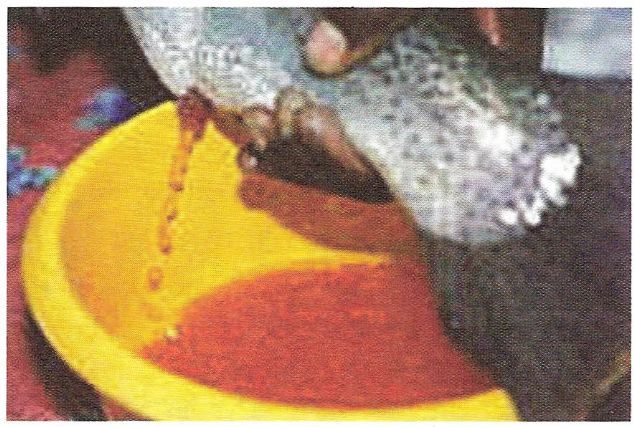 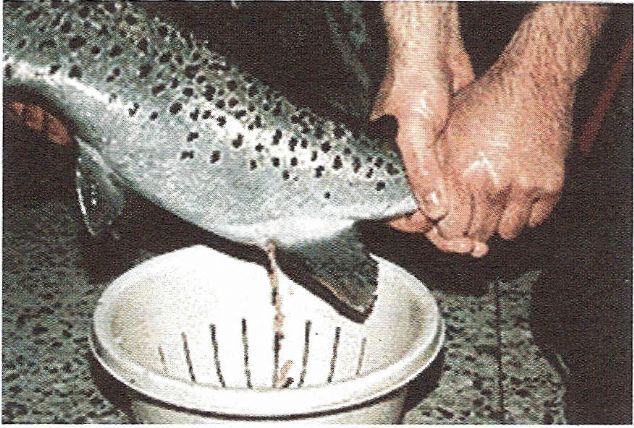 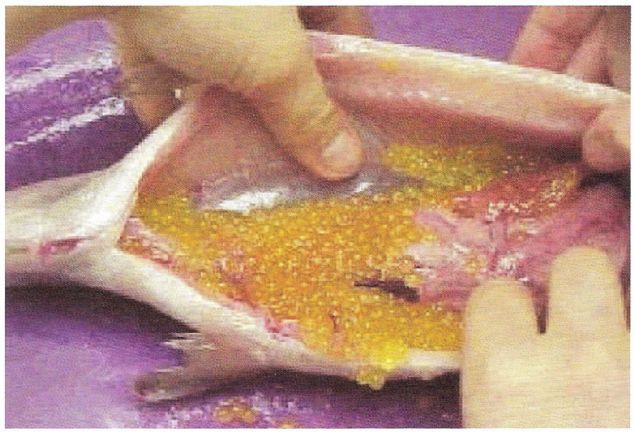 Picture: Milking eggs (top) in trout and the appearance of eggs in a trout with a split belly. Eggs and production are similar in trout and salmon. (Bottom)
After the eggs of two or four females are milked in the same container, the milk of two males is milked on the eggs. The male fish should be dried before milking. Especially in the tail and anus, there should be no water that can drip. If water drops from these parts on the milk, male reproductive cells die in a short time. In female fish, the egg is removed by applying pressure to the abdomen. In male fish, milk is extracted by pressing the sides of the abdomen. A few drops of milk are enough to fertilize a container of eggs. For the definitive result, milk taken from two men is used jointly. If one of the fish is infertile, the sperm of the other fish will be sufficient to fertilize all the eggs. After milking the eggs, the eggs are gently mixed with the feather. The mixed eggs are placed in a bowl filled with water up to half. This time the eggs are quickly mixed with the fluff. This mixing process is sufficient to rotate the water 3-4 times. Thus, the fertilization process is completed. Eggs are washed 5-6 times after being kept in the container for 20 minutes. With this washing process, bad eggs, blood and milk residues are removed. Cleaned eggs are placed in egg pans and the process is completed. If the milking place is far from the incubator pans, the eggs should be transported in a closed and light-free container. However, many breeders take care that the milking place is close to the brood pans. Thus, after milking, the eggs are placed in pans and quickly placed in the hatchery places. Within the first 36 hours after fertilization, eggs can be moved very carefully from one place to another. After this period, until the eyes develop as two black spots; It is very dangerous to transport eggs within 14-16 days. During this period, eggs should not be moved as much as possible. Because they are very sensitive. Meanwhile, they should not be subjected to any sudden movement or shock. The water flow must be regulated very carefully. The water should not move the eggs. After 15 days, eggs can be transported from one establishment to another. Fertilized egg trade in the world is carried out during this period. During this period, eggs can be sent anywhere in the world by plane. If the number of dead eggs is low, it may even be neglected to remove them during this period. It would be good if the dead egg extraction process is done between 1-7 days. Removal of dead eggs is an important issue, and dead eggs are immediately noticeable among normal eggs as white and dull color. Sorting is make with tweezers or small tongs specially made from straw. Dead eggs can also be removed by sucking with a small tube. In some businesses, practical tools with a rubber ball like a ball and a small hose at the end are used for the suction process. For this process, materials with pictures on the upper part can also be used. Especially in businesses that have the potential to milk thousands of eggs, it would be good to use machines that extract dead eggs from live ones. When the fry begin to hatch, the remaining egg shells must be removed and discarded. If there is a lott of fungus and dead eggs, the eggs can be subjected to a 1 / 300,000 dilution of malachite and chile baths once every 5-6 days. In this way, fungus can be reduced or prevented.
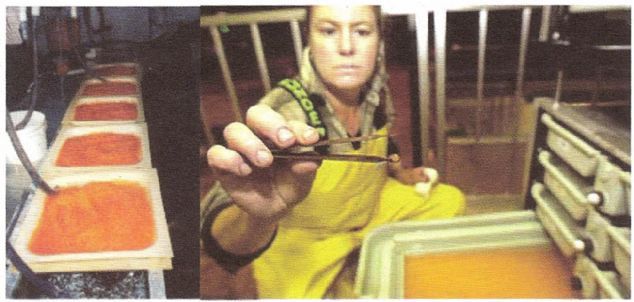 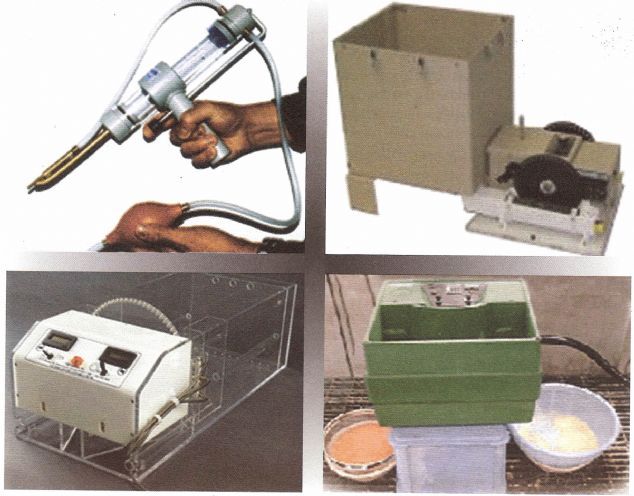 Picture: (Top): Removal of dead or mushroom eggs with tweezers is applied similarly to salmon and trout eggs. Egg colors can be different according to the species. Rainbow trout eggs are close to pink in nature. Pale white color can be seen in the production made in the pools. (Alt): Dead egg sorting and counting machines used in trout farming. NUTRITION OF TROUTS- PUPPY CARE and NUTRITION
The young hatchlings are very gentle. In general, if the holes of the brood trays are wide enough not to prevent the fish from passing, the offspring move to the lower part of this tray and stand still as if resting at the bottom. During this period, the pool floor should be cleaned very well. The marsupials that will die during this period should also be cleaned and weeded immediately. The water given should be clean and less mobile. Before the food sac is lost, the fish move and swim to the surface of the water in search of food. Feeding is started during this period. After hatching from trout eggs, the fry do not need to be fed. Because the juvenile fish are fed from the food sac under their bellies. This time may vary depending on the temperature of the water and the fish species. For example, rainbow trout juveniles can starts to feed from 18-20 days at water temperatures of 14-16 degrees. In this regard, as a general rule, when the food sac under the abdomen of the juvenile fish starts to decrease, the fish are given food gradually. Feeding should be done very carefully. Feeding should be continued by carefully examining whether the puppies take the feed or not. In ancient times, it was common practice to feed juvenile trout by crushing the spleen and liver. However, the spleen feeding process has decreased today. Feeding is mostly followed with powder feeds. This has various conveniences. First of all, it is easy to stock powder feeds. Foods such as spleen should be provided every day. For this reason, we will recommend that juvenile fish be fed with powder feed. Powder feeds used while feeding juveniles should be rich in protein. For this purpose, it would be beneficial to contain an average of 40% fish meal. If powder feed specially prepared for juvenile fish is difficult to obtain, some breeders feed the juvenile fish with powder feed obtained by sieving the pellet feeds prepared for adult fish. They are successful, albeit partially. We can recommend this path for any grower in trouble. Some fish meal, blood, crushed spleen or beef liver can be added to this powder feed obtained by sieving. Practically, the feeding problem of juvenile fish is solved. While the young fish are feeding, a small amount of feed is given in the first days. The amount of feed given to the fish is increased a little every day and the fish get used to it. Feeding should be done in small amounts 4-5 times during the day. During the feeding process, feed consumption should be carefully controlled. It should not be allowed to collapse to the bottom before the feed is consumed. Because the baits that sink to the bottom without consumption cannot be taken by the juvenile fish. These baits decompose over time and cause the pool environment to deteriorate.
NUTRITION OF ADULT FISH
There are three ways to feed trout. These are feeding with fresh wet feeds, mixed feeds and pellet feeds. All kinds of fish and other animal products in fresh fresh feeds can be used for this purpose. Successful breeding is possible especially with the feeding process that can be made with the fish that can be obtained cheaply. However, it can be difficult for such feeds to be constantly available and affordable. Also, great attention should be paid to contamination in this type of feeding process. This practice is seen in northern countries, where a large amount of discard fish has been caught in recent years. In some cases in our country, it is possible to feed fish with such feeds in addition to pellet feed. In this case, the second feeding method, which we call mixed feeding, is applied. The most economical and practical way of feeding in trout farming today is made with pellet feeds. The benefits of using pellet feeds are many. First of all, they are always readily available. They are easy to store. By making a planning according to the amount and weight of the fish, it is possible to give the required amount of feed. For this reason, the method of feeding with pellet feed is recommended in our country. This is the most suitable form of feeding. Trouts are generally carnivorous animals. Therefore, feeds used to feed trout should be rich in protein. Trout feeds should contain at least 30-35% protein. In addition, it will be better if the protein source comes from the fish. The amount of feed to be given to fish is generally around 2% of the total live weight.
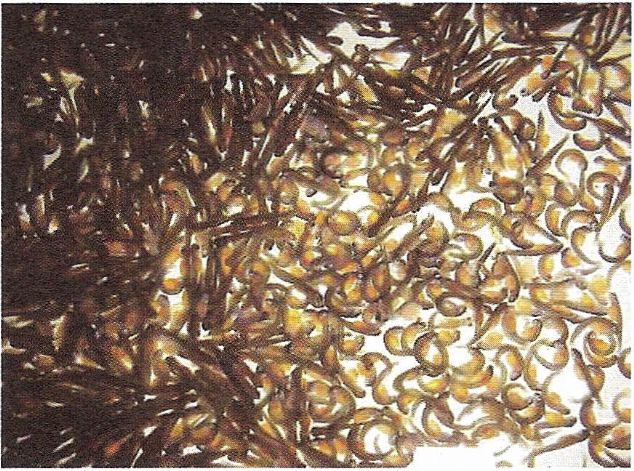  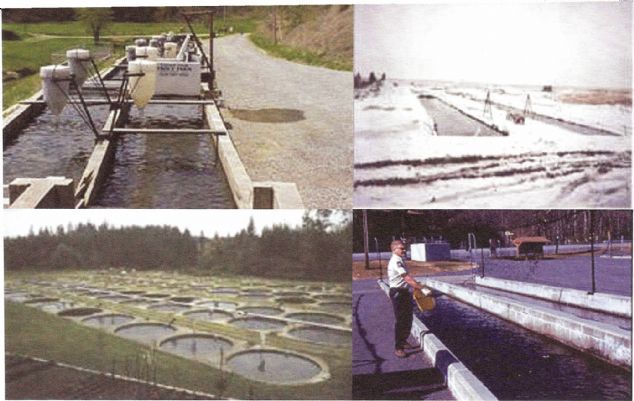 Top: Food marsupial trout juveniles and a freshly hatched food marsupial trout larva in the middle. Buttom: Different pond applications used in trout farming. Using automatic feeders in trout farming reduces labor costs. DISEASES Diagnosing fish diseases requires specific information. When the disease occurs, it would be best to call an experienced veterinarian. For producers, it is important to consider and ensure the precautions that will prevent diseases. A regular and balanced diet is essential to prevent diseases. Fish should not be kept more often than usual. Water facilities should be sufficient at all times. When fish are purchased from other businesses, the fish should be kept in quarantine for a while.
DIAGNOSIS OF DISEASES Diseases in fish occur in various ways, such as decreased appetite, observing abnormal movements, death, seeing and increasing blindness, eye bursting, and gathering of fish at water exit and entry points. In general, fish trying to escape from the pond may indicate a problem with the pond water. Pool water should be controlled. It is checked whether there is bottom feed residue on the pool floor and cleaned if there is any. There is a possibility of a parasite problem if the fish have rashes or blood stains on their bodies. If sudden deaths occur in fish, the first thing to come to mind should be the quality of the feed. In this case, the feed should be reduced immediately or replaced if possible. Such protective and preventive measures should not be neglected. Some of the important diseases of trout are summarized below: FRUNKULOSIS: There are wounds on the outer parts of the fish. Some wounds are in the form of pits. There are inflammations in the gills. In juveniles, the spleen is enlarged and appears red. Kidneys are soft. Juvenile trout tend to gather in shady areas. In the treatment of this disease, 15 kg of sulfamerazine is mixed into the daily feed for 100 kg of trout and this application is continued until the disease is over. RESPIRATORY DISEASE: The gills are swollen and covered with mucosa. In the advanced period, the diseased areas bleed and the area around the mouth is covered with wounds. The fish become immobile and do not want to be fed. The gills become pale. It is a disease that can be harmful in juvenile trout. In its treatment, a 2-minute immersion bath in 1/200 copper sulphate solution, a 2-second dipping bath in 1 / 15,000 malachite green, and adding 2 grams of sulfamerazine to the daily feed for 100 kg of trout are applied. Fish are fed in this way for a week. VIBRIOSIS: Swelling appears on the body, inside of which is filled with pus. Blood accumulations are seen in fin connections. The anus becomes protruding and puffy swelling is seen in the eyes. There is a darkening of the overall color of the body. In the internal organs, the spleen swells, the kidney begins to melt, and the digestive organs are covered with a yellowish mucosa. It is recommended to feed for a week by adding 0.3% terramycin or 0.2% furazolidone into the feeds. KOSTIASIS: It is a parasitic disease. It can be recognized by the appearance of rust-colored spots on the body and fins. Malahir green bath or formaldehyde bath (with OlSAO) is recommended. ICHTHYAPHTHIRIASIS DISEASE: Brightness has increased in fish. Small white pouches are seen on the body. There is a clumping whiteness on the gills. A 1-2 hour bath in a 1 / 4.000 formaldehyde solution is recommended. Continuous cleaning, disposal of dead fish immediately, changing the pond and transferring the fish to another pool with abundant water flow accelerate the treatment. OKTOMITUS: It is a disease seen in the digestive organs. The fish begin to become extremely skinny and often have diarrhea. In some parts of the body, it is observed that the skin turns black. Definitive diagnosis is made by microscope control. It is recommended to mix 0.2% fumagillin or 0.2% carborsane into the feeds. ROTATION DISEASE (Whirling): Especially seen in juvenile trout. The sick trout start spinning where they are. If these trout or the number of trout juveniles in the pond with the disease are low, it may even be considered to destroy all of the fish. VIRAL SEPTISEMI: The exact treatment of this disease, which is seen in trout older than one year, is unknown. It is seen that the body turns black and the eyes pop out in sick fish. Trout swim in circles in the water and become skinny. THYROID TUMORS: It is a disease caused by the swelling of the thyroid glands in fish. This disease caused by iodine deficiency can be prevented by adding iodized salt into feeds. OTHERS: Fish diseases are a deep sea issue. In particular, poor quality of feed causes many diseases. For this reason, using quality feed and providing a clean growing environment is essential for a healthy production. The low protein ratio in diets can cause various gill diseases and digestive disorders. Diets prepared with spoiled feed may cause unexpected malfunctions in the livers. It may be the main cause of nutritional deficiencies, anemia and wasting diseases. Problems caused by mineral and vitamin deficiencies can often create the appearance of unknown diseases. Because the damages caused by all kinds of vitamin deficiencies in the body are different. Feeding with excessive fatty foods can cause fatty liver and infertility. Moldy feeds can cause a disease called visceral granuloma that causes swelling of the kidney and the formation of light gray colored modules in the kidney. Prolonged hunger can lead to frailty and eventually death. Health problems can occur with detergents and other residual substances in the water. It is very dangerous to use substances such as formol, methylene blue, malachite green, which are used to prevent diseases, in excess of normal doses and may cause mass death. Lime, cement, paint residues, oxygen deficiency, sudden increase or decrease in water hardness, critical changes in pH status can lead to many health problems and death. As a result, environmental conditions must be kept at the best level. Necessary oxygen should be provided by planning the feeding very well and by regulating the frequency of fish well. Clean water should be given to the pools without interruption. It should not be forgotten that a successful breeding is possible by taking the necessary precautions instead of treating the diseases.
DISEASES Diagnosing fish diseases requires specific information. When the disease occurs, it would be best to call an experienced veterinarian. For producers, it is important to consider and ensure the precautions that will prevent diseases. A regular and balanced diet is essential to prevent diseases. Fish should not be kept more often than usual. Water facilities should be sufficient at all times. When fish are purchased from other businesses, the fish should be kept in quarantine for a while.
DIAGNOSIS OF DISEASES Diseases in fish occur in various ways, such as decreased appetite, observing abnormal movements, death, seeing and increasing blindness, eye bursting, and gathering of fish at water exit and entry points. In general, fish trying to escape from the pond may indicate a problem with the pond water. Pool water should be controlled. It is checked whether there is bottom feed residue on the pool floor and cleaned if there is any. There is a possibility of a parasite problem if the fish have rashes or blood stains on their bodies. If sudden deaths occur in fish, the first thing to come to mind should be the quality of the feed. In this case, the feed should be reduced immediately or replaced if possible. Such protective and preventive measures should not be neglected. Some of the important diseases of trout are summarized below: FRUNKULOSIS: There are wounds on the outer parts of the fish. Some wounds are in the form of pits. There are inflammations in the gills. In juveniles, the spleen is enlarged and appears red. Kidneys are soft. Juvenile trout tend to gather in shady areas. In the treatment of this disease, 15 kg of sulfamerazine is mixed into the daily feed for 100 kg of trout and this application is continued until the disease is over. RESPIRATORY DISEASE: The gills are swollen and covered with mucosa. In the advanced period, the diseased areas bleed and the area around the mouth is covered with wounds. The fish become immobile and do not want to be fed. The gills become pale. It is a disease that can be harmful in juvenile trout. In its treatment, a 2-minute immersion bath in 1/200 copper sulphate solution, a 2-second dipping bath in 1 / 15,000 malachite green, and adding 2 grams of sulfamerazine to the daily feed for 100 kg of trout are applied. Fish are fed in this way for a week. VIBRIOSIS: Swelling appears on the body, inside of which is filled with pus. Blood accumulations are seen in fin connections. The anus becomes protruding and puffy swelling is seen in the eyes. There is a darkening of the overall color of the body. In the internal organs, the spleen swells, the kidney begins to melt, and the digestive organs are covered with a yellowish mucosa. It is recommended to feed for a week by adding 0.3% terramycin or 0.2% furazolidone into the feeds. KOSTIASIS: It is a parasitic disease. It can be recognized by the appearance of rust-colored spots on the body and fins. Malahir green bath or formaldehyde bath (with OlSAO) is recommended. ICHTHYAPHTHIRIASIS DISEASE: Brightness has increased in fish. Small white pouches are seen on the body. There is a clumping whiteness on the gills. A 1-2 hour bath in a 1 / 4.000 formaldehyde solution is recommended. Continuous cleaning, disposal of dead fish immediately, changing the pond and transferring the fish to another pool with abundant water flow accelerate the treatment. OKTOMITUS: It is a disease seen in the digestive organs. The fish begin to become extremely skinny and often have diarrhea. In some parts of the body, it is observed that the skin turns black. Definitive diagnosis is made by microscope control. It is recommended to mix 0.2% fumagillin or 0.2% carborsane into the feeds. ROTATION DISEASE (Whirling): Especially seen in juvenile trout. The sick trout start spinning where they are. If these trout or the number of trout juveniles in the pond with the disease are low, it may even be considered to destroy all of the fish. VIRAL SEPTISEMI: The exact treatment of this disease, which is seen in trout older than one year, is unknown. It is seen that the body turns black and the eyes pop out in sick fish. Trout swim in circles in the water and become skinny. THYROID TUMORS: It is a disease caused by the swelling of the thyroid glands in fish. This disease caused by iodine deficiency can be prevented by adding iodized salt into feeds. OTHERS: Fish diseases are a deep sea issue. In particular, poor quality of feed causes many diseases. For this reason, using quality feed and providing a clean growing environment is essential for a healthy production. The low protein ratio in diets can cause various gill diseases and digestive disorders. Diets prepared with spoiled feed may cause unexpected malfunctions in the livers. It may be the main cause of nutritional deficiencies, anemia and wasting diseases. Problems caused by mineral and vitamin deficiencies can often create the appearance of unknown diseases. Because the damages caused by all kinds of vitamin deficiencies in the body are different. Feeding with excessive fatty foods can cause fatty liver and infertility. Moldy feeds can cause a disease called visceral granuloma that causes swelling of the kidney and the formation of light gray colored modules in the kidney. Prolonged hunger can lead to frailty and eventually death. Health problems can occur with detergents and other residual substances in the water. It is very dangerous to use substances such as formol, methylene blue, malachite green, which are used to prevent diseases, in excess of normal doses and may cause mass death. Lime, cement, paint residues, oxygen deficiency, sudden increase or decrease in water hardness, critical changes in pH status can lead to many health problems and death. As a result, environmental conditions must be kept at the best level. Necessary oxygen should be provided by planning the feeding very well and by regulating the frequency of fish well. Clean water should be given to the pools without interruption. It should not be forgotten that a successful breeding is possible by taking the necessary precautions instead of treating the diseases.
 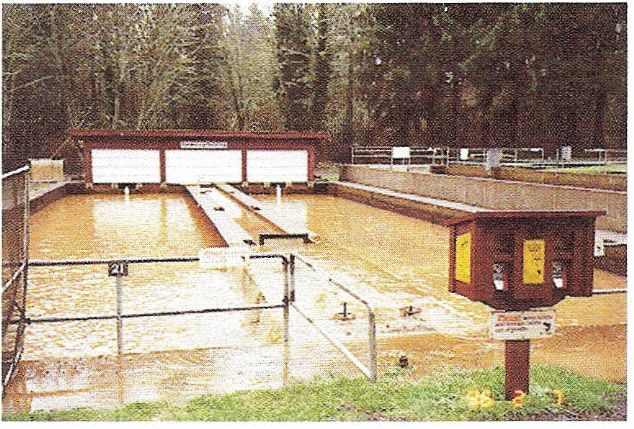 Picture: (Top) Vaccination in trout. (Bottom): Trout production facilities should not be established in places where flooding is likely.
|




